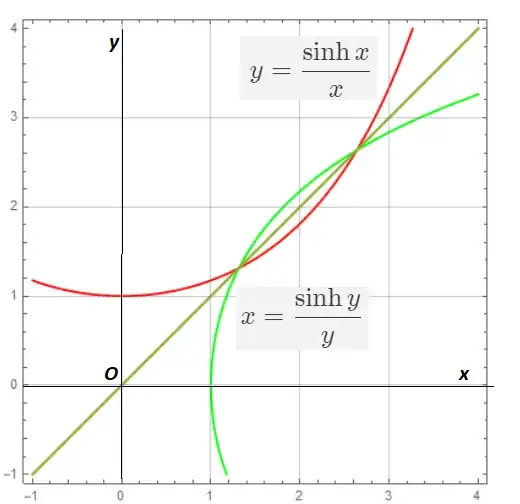This isn't really an answer, but perhaps provides some insight with respect to a closed-form representation for $F(s)=\mathcal{M}_t[f(t)](s)$ where $f(t)$ is the inverse function of $x\, \text{csch}(x)$.
The Mellin transform result can be expressed as
$$F(s)=\mathcal{M}_x[f(t)](s)=2^s\, \Gamma(s)\, G(s)\tag{1}$$
where
$$G(s)=\underset{N\to\infty}{\text{lim}}\left(\sum\limits_{n=0}^N \binom{-s}{n}\, \frac{(-1)^n}{(2 n+s)^{s+1}}\right)\tag{2}.$$
$G(s)$ seems to have a closed-form representation at non-zero integer values of $s$ as illustrated in the following table. I'm wondering if Mathematica understands $G(s)$ in terms other known functions at least when $G(s)$ is evaluated at non-zero integer values of $s$.
$$\begin{array}{ccc}
s & G(s)=\sum\limits_{n=0}^{\infty} \binom{-s}{n}\, \frac{(-1)^n}{(2 n+s)^{s+1}} & F(s)=2^s\, \Gamma (s)\, G(s) \\
-5 & 0 & - \\
-4 & 0 & - \\
-3 & 0 & - \\
-2 & 0 & - \\
-1 & 0 & - \\
0 & - & - \\
1 & \frac{\pi ^2}{8} & \frac{\pi ^2}{4} \\
2 & \frac{\pi ^2}{48} & \frac{\pi ^2}{12} \\
3 & -\frac{1}{768} \pi ^2 \left(\pi ^2-12\right) & -\frac{1}{48} \pi ^2 \left(\pi ^2-12\right) \\
4 & -\frac{\pi ^2 \left(\pi ^2-15\right)}{17280} & -\frac{1}{180} \pi ^2 \left(\pi ^2-15\right) \\
5 & \frac{\pi ^2 \left(120-100 \pi ^2+9 \pi ^4\right)}{368640} & \frac{1}{480} \pi ^2 \left(120-100 \pi ^2+9 \pi ^4\right) \\
6 & \frac{\pi ^2 \left(315-105 \pi ^2+8 \pi ^4\right)}{29030400} & \frac{\pi ^2 \left(315-105 \pi ^2+8 \pi ^4\right)}{3780} \\
7 & \frac{6720 \pi ^2-19600 \pi ^4+14504 \pi ^6-1275 \pi ^8}{2477260800} & \frac{6720 \pi ^2-19600 \pi ^4+14504 \pi ^6-1275 \pi ^8}{26880} \\
8 & \frac{1575 \pi ^2-1470 \pi ^4+490 \pi ^6-36 \pi ^8}{24385536000} & \frac{1575 \pi ^2-1470 \pi ^4+490 \pi ^6-36 \pi ^8}{18900} \\
9 & \frac{\pi ^2 \left(40320-282240 \pi ^2+663264 \pi ^4-439144 \pi ^6+37975 \pi ^8\right)}{3329438515200} & \frac{\pi ^2 \left(40320-282240 \pi ^2+663264 \pi ^4-439144 \pi ^6+37975 \pi ^8\right)}{161280} \\
10 & \frac{\pi ^2 \left(3465-6930 \pi ^2+6006 \pi ^4-1804 \pi ^6+128 \pi ^8\right)}{15450675609600} & \frac{\pi ^2 \left(3465-6930 \pi ^2+6006 \pi ^4-1804 \pi ^6+128 \pi ^8\right)}{41580} \\
\end{array}$$
Its worth noting a couple of points about the results in the table above.
First, when evaluated at positive integers $G(s)$ seems to be of the form
$$G(s)=\frac{1}{b_s} \sum\limits_{k=1}^{\left\lceil \frac{s}{2}\right\rceil} a_{s,k}\, \pi^{2 k}\tag{3}$$
where there's an extra term introduced in the numerator at every successive odd positive integer which is perhaps a clue.
Second, when $s$ is a negative integer its sufficient to evaluate the sum in formula (2) above using the upper evaluation limit $N=|s|$ since for the term of $G(s)$ one has
$$\binom{-s}{n}\, \frac{(-1)^n}{(2 n+s)^{s+1}}=0\,,\quad s\in \mathbb{Z}\land s<0\land n\in \mathbb{Z}\land n>|s|\tag{4}$$
which is analogous to how some globally convergent series for the Riemann zeta function $\zeta(s)$, the Dirichlet eta function $\eta(s)$, and formulas (5c) and (5d) below for $H_a(s)$ defined in formula (5a) below (which is more closely related to this question) converge at finite evaluation limits at negative integer values of $s$. In formula (5a) below $\zeta(s,a)$ is the Hurwitz zeta function.
$$H_a(s)=4^{-s-1} \left(\zeta\left(s+1,\frac{a}{4}\right)-\zeta\left(s+1,\frac{a+2}{4}\right)\right)\tag{5a}$$
$$H_a(s)=\underset{K\to\infty}{\text{lim}}\left(\sum\limits_{n=0}^K \frac{(-1)^n}{(2 n+a)^{s+1}}\right),\quad\Re(s)>0\tag{5b}$$
$$H_a(s)=\underset{K\to\infty}{\text{lim}}\left(\sum\limits_{n=0}^K \frac{1}{2^{n+1}} \sum\limits_{k=0}^n \binom{n}{k}\frac{(-1)^k}{(2 k+a)^{s+1}}\right)\tag{5c}$$
$$H_a(s)=\underset{K\to\infty}{\text{lim}}\left(\frac{1}{2^{K+1}} \sum\limits_{n=0}^K \frac{(-1)^n}{(2 n+a)^{s+1}} \sum\limits_{k=0}^{K-n} \binom{K+1}{K-k-n}\right)\tag{5d}$$
Ignoring the binomial term $\binom{-s}{n}$ in formula (2) above for $G(s)$ one has
$$\sum\limits_{n=0}^{\infty} \frac{(-1)^n}{(2 n+s)^{s+1}}=4^{-s-1} \left(\zeta \left(s+1,\frac{s}{4}\right)-\zeta \left(s+1,\frac{s+2}{4}\right)\right)\tag{6}$$
which is equivalent to formulas (5a) and (5b) above for $H_a(s)$ evaluated at $a=s$, but I'm not sure how to account for the binomial term $\binom{-s}{n}$ in formula (2) above. I believe formulas (5c) and (5d) for $H_a(s)$ above are globally convergent for the case $a=s$ as well as when $a$ is a constant.
Figures (1) and (2) below illustrate the real and imaginary parts of formula (2) for $G(s)$ above evaluated at $N=100$ and $N=1000$ in blue and orange respectively. Note $G(s)$ seems to have a pole at $s=0$, converge to zero as $s\to\infty$, and typically has both imaginary and real components when evaluated for $s<0$, but seems to evaluate to zero at negative integer values of $s$ consistent with the table above. I'm not sure if formula (2) for $G(s)$ above is globally convergent, but it if is evaluations seem to indicate it converges more slowly for $\Re(s)<0$ than for $\Re(s)>0$.

Figure (1): Illustration of real part of formula (2) for $G(s)$ evaluated at $N=100$ and $N=1000$ in blue and orange respectively

Figure (2): Illustration of imaginary part of formula (2) for $G(s)$ evaluated at $N=100$ and $N=1000$ in blue and orange respectively
I noticed splitting the evaluation of $G(s)$ into two steps including
$$H(z)=\sum\limits_{n=0}^{\infty} \binom{-z}{n} \frac{(-1)^n}{(2 n+z)^{s+1}}\tag{7}$$
and
$$G(s)=\underset{z\to s}{\text{lim}}\, H(z)\tag{8}$$
leads to a functional representation of $H(z)$ at positive integer values of $s$ (and hence $G(s)$ in a limit sense) as illustrated in the following table.
$$\begin{array}{cccc}
s & G(s)=\sum\limits_{n=0}^{\infty} \binom{-s}{n} \frac{(-1)^n}{(2 n+s)^{s+1}} & G(s)=\underset{z\to s}{\text{lim}}\, H(z) & H(z)=\sum\limits_{n=0}^{\infty} \binom{-z}{n} \frac{(-1)^n}{(2 n+z)^{s+1}} \\
1 & \frac{\pi ^2}{8} & \frac{\pi ^2}{8} & \sqrt{\pi } 2^{-z-2} \cot \left(\frac{\pi z}{2}\right) \Gamma \left(\frac{1}{2}-\frac{z}{2}\right) \Gamma \left(\frac{z}{2}\right) \\
2 & \frac{\pi ^2}{48} & \frac{\pi ^2}{48} & \frac{2^{-z-4} \Gamma \left(\frac{1}{2}-\frac{z}{2}\right) \Gamma \left(\frac{z}{2}\right) \left(\pi ^2 \cot ^2\left(\frac{\pi z}{2}\right)+\psi ^{(1)}\left(\frac{z}{2}\right)-\psi ^{(1)}\left(1-\frac{z}{2}\right)\right)}{\sqrt{\pi }} \\
3 & -\frac{1}{768} \pi ^2 \left(\pi ^2-12\right) & -\frac{1}{768} \pi ^2 \left(\pi ^2-12\right) & \frac{1}{3} \sqrt{\pi } 2^{-z-5} \Gamma \left(\frac{1}{2}-\frac{z}{2}\right) \Gamma \left(\frac{z}{2}\right) \left(3 \cot \left(\frac{\pi z}{2}\right) \left(\psi ^{(1)}\left(\frac{z}{2}\right)-\psi ^{(1)}\left(1-\frac{z}{2}\right)\right)+\pi ^2 \left(\cot ^3\left(\frac{\pi z}{2}\right)+\sin (\pi z) \csc ^4\left(\frac{\pi z}{2}\right)\right)\right) \\
4 & -\frac{\pi ^2 \left(\pi ^2-15\right)}{17280} & -\frac{\pi ^2 \left(\pi ^2-15\right)}{17280} & \frac{2^{-z-8} \Gamma \left(\frac{1}{2}-\frac{z}{2}\right) \Gamma \left(\frac{z}{2}\right) \left(\psi ^{(0)}\left(\frac{z}{2}\right)^4+\psi ^{(0)}\left(1-\frac{z}{2}\right)^4+3 \left(\psi ^{(1)}\left(1-\frac{z}{2}\right)-\psi ^{(1)}\left(\frac{z}{2}\right)\right)^2-4 \psi ^{(0)}\left(1-\frac{z}{2}\right)^3 \psi ^{(0)}\left(\frac{z}{2}\right)+6 \psi ^{(0)}\left(\frac{z}{2}\right)^2 \left(\psi ^{(1)}\left(\frac{z}{2}\right)-\psi ^{(1)}\left(1-\frac{z}{2}\right)\right)+6 \psi ^{(0)}\left(1-\frac{z}{2}\right)^2 \left(\psi ^{(0)}\left(\frac{z}{2}\right)^2+\psi ^{(1)}\left(\frac{z}{2}\right)-\psi ^{(1)}\left(1-\frac{z}{2}\right)\right)-4 \psi ^{(0)}\left(1-\frac{z}{2}\right) \left(\psi ^{(0)}\left(\frac{z}{2}\right)^3+3 \left(\psi ^{(1)}\left(\frac{z}{2}\right)-\psi ^{(1)}\left(1-\frac{z}{2}\right)\right) \psi ^{(0)}\left(\frac{z}{2}\right)+\psi ^{(2)}\left(\frac{z}{2}\right)-\psi ^{(2)}\left(1-\frac{z}{2}\right)\right)+\psi ^{(3)}\left(\frac{z}{2}\right)-\psi ^{(3)}\left(1-\frac{z}{2}\right)-4 \pi ^3 \sin (\pi z) \csc ^4\left(\frac{\pi z}{2}\right) \psi ^{(0)}\left(\frac{z}{2}\right)\right)}{3 \sqrt{\pi }} \\
\end{array}$$




